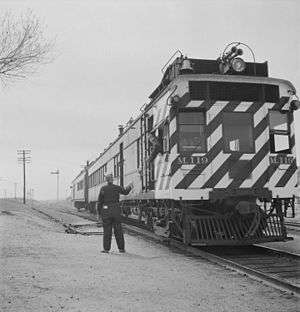Doodlebug (rail car)
| ”Doodlebug” | |
|---|---|
|
East Broad Top No. M1, a narrow gauge gas-electric doodlebug that was constructed by EBT from a Brill manufactured kit | |
| Manufacturer | various, including EMC/Pullman, Brill/Mack, McKeen Motor Car Company, Rio Grande Southern Railroad |
| Specifications | |
| Car body construction | Coach/baggage combine |
| Prime mover(s) | various (gasoline, diesel) |
| Transmission | various (mechanical, electric, hydraulic) |
| AAR wheel arrangement | usually B-2 |
| Track gauge | 4 ft 8 1⁄2 in (1,435 mm) and 3 ft (914 mm) |
In the United States, doodlebug was the common name for a self-propelled railcar. While such a coach typically had a gasoline-powered engine that turned a generator which provided electricity to traction motors, which turned the axles and wheels on the trucks, versions with mechanical transmissions also existed.
Doodlebugs sometimes pulled an unpowered trailer car, but were more often used singularly. They were popular with some railroads during the first part of the 20th century to provide passenger and mail service on lightly used branch lines, obviating the need to operate conventional trains consisting of a locomotive and coaches. Several railroads, mostly small regional and local networks, provided their main passenger services through doodlebugs in a cost cutting effort.
History
While interest in self-propelled cars did exist before the late 1910s in the form of the electric trolley and streetcar as well as a few other examples, the better portion of doodlebug usage in the United States can be traced to this time period. Electro-Motive, then in the form of the Electro-Motive Corporation as the General Motors purchase had not yet occurred, began the large scale production of self- propelled railcars using bodies manufactured by Pullman and the St. Louis Car Company. By the 1920s the gas-electric car had become one of the main providers of branch-line service.


Origin of term
The term "doodlebug" was given to the first successful motor car, the Union Pacific #1 McKeen Motor Car, built in late 1904 to March 1905. When the motor car first arrived for service in Kearney, Nebraska, the switchman looked at the Maroon colored, knife edge nose, gasoline motor car, and proclaimed, "Look at the potato bug." Although this is not when the doodlebug term was coined, it was probably around the same time that railroaders created this nickname.
See also
- Budd Rail Diesel Car
- CPH railmotor
- Dracar
- Doodlebug Disaster
- Edwards Rail Car Company
- FM OP800
- Hoodlebug
- Interurban
- McKeen Motor Car Company
- Railcar
- Steam dummy
- SAL 2027
References
- Dorin, Patrick C. (1972). Chicago and NorthWestern Power. Superior Publishing. pp. 182, 188. ISBN 0-87564-715-4.
Further reading
- Edmund Keilty (September 1979). Interurbans without wires: the rail motorcar in the United States. Interurbans. ISBN 978-0-916374-38-9.
- Edmund Keilty (September 1982). Doodlebug country: the rail motorcar on the Class 1 railroads of the United States. Interurban Press. ISBN 978-0-916374-50-1.
- Edmund Keilty (December 1988). The Short Line Doodlebug: Galloping Geese and Other Rail Critters. Interurban Press. ISBN 978-0-916374-77-8.
External links
- Doodlebugs at american-rails.com. Retrieved October 10, 2012
- Doodlebugs in Jacksonville, Florida http://www.jaxhistory.com/Jacksonville%20Story/Picture%20of%20Jax%20Train,%20Doodlebug.htm
